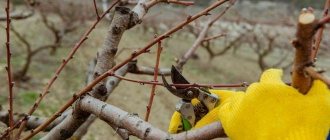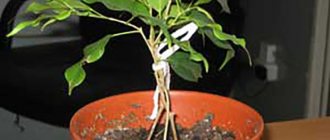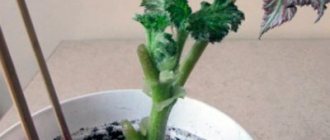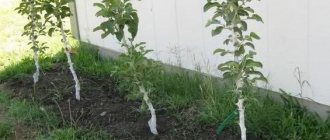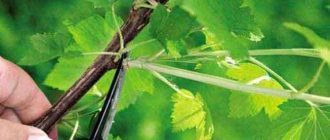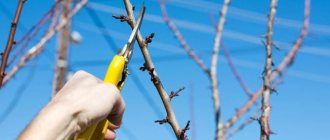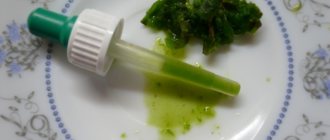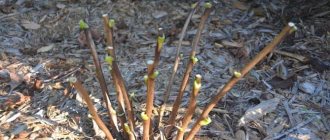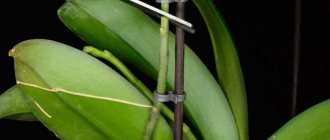The false palm is an undemanding houseplant that can be given any shape if you follow the conditions for how to prune dracaena to get a lush crown. It plays a role in what period of the growing season to carry out the procedure at home, how to prevent the stem from drying out and obtain planting material for transplanting, because the trimmings can be rooted next to the main plant and get an ornamental bush with plantings of different sizes.
Features of dracaena
Dracaena differs in that without pruning or adjusting the trunk it only grows upward. In this case, the lower leaves die off naturally, and the trunk becomes bare and loses its decorative effect. It happens that a plant has grown to the ceiling, but there are leaves only at the top. Such a specimen must be pruned and propagated (the trunk can be sprinkled with soil, watered, and after a while new bushes will appear from the internodes, which can be transplanted into a separate container).
Dracaena grows slowly. The top of the trunk, where the leaves are located, is green, but the trunk below becomes woody as the leaves die. The main thing in care is not to overwater the plant, otherwise it will die. Dracaena will tolerate infrequent watering (but regular), but will not tolerate growing in wet soil.
Beginner gardeners are wondering whether it is possible to prune dracaena themselves, so as not to spend money on an adult, decorated plant in the supermarket. Since these species grow for a long time, the price for a lush dracaena with many trunks will not be small.
It is recommended to prune dracaena at home:
- for plant rejuvenation;
- getting rid of diseases or insects;
- performing bush molding;
- to select cuttings for propagation of a flower whose root system does not produce offspring or children.
There is also sanitary pruning, which prepares the palm tree for wintering. Trimming dracaena leaves is important, since even semi-dry foliage takes away nutrients and depletes the bush.
How to prune and re-shape a plant
With all the variety of forms and varieties of dracaenas, they have a common feature: the trunk grows in height and branches extremely rarely.
Why prune dracaena:
- To improve appearance and increase decorativeness, dracaena is rejuvenated - elongated shoots are shortened by pruning. Since the peculiarity of the plant is the fall of the lower leaves of the crown during fairly rapid growth, often elongated shoots take on an unsightly appearance (they become bent, deformed, etc.);
- to form a lush crown. Along the entire trunk of the dracaena there are dormant buds that are invisible to us. Removing part of the trunk stimulates the awakening of such buds just under the cut; side shoots will appear from them, which, when they grow up, will increase the mass of leaves. By increasing the number of shoots, a more luxuriant crown is formed;
- for growing multi-stemmed plants and simulating bonsai. In this case, the trunk is cut closer to the ground or at a low height, and then over the years the crown is formed;
- to preserve the plant. If the dracaena fell and broke or got sick and began to die rapidly, to save at least parts of the plant, the tops or parts of the branches are cut off and rooted;
- for reproduction. Apical and stem cuttings take root quite easily; in addition, stem cuttings are capable of producing lateral shoots from dormant buds.
Reasons for cutting a flower
Basically, the plant owner relies on his own opinion and taste. If, from your point of view, the dracaena has reached a significant height, has a bare trunk with a tuft of leaves on the top and has lost its former attractiveness, you want to renew and rejuvenate the plant or get a multi-stemmed dracaena specimen instead of a single-stemmed one, then by pruning you can adjust the height of the plant, the density of the crown and the whole appearance.
When should you prune?
There is an important rule: this procedure is carried out exclusively on healthy plants and only during the period of active growth - in spring or summer. The fact is that during the growing season, the plant body produces special substances for the construction of new cells and for the successful healing of wounds. In winter, during the period of low temperatures and decreased intensity of sunlight, it is very difficult for the plant to endure such stress. And weakened plants may even die.
The only exceptions are emergency cases. For example, when the dracaena is broken or the top (trunk) is damaged (rots), or if its top rests against the ceiling, then urgent pruning is allowed. In this case, you will need to pay additional attention to caring for the plant so that the dormant buds of the dracaena can safely germinate.
Dried or rotten dracaena leaves may be a signal for an emergency transplant.
No special in-depth knowledge is required to perform pruning yourself. It is advisable to simply have an idea of the process.
What happens if you pinch (cut) a dracaena; Is it possible to trim the top, shorten part of the trunk, cut off the leaves?
Some plant lovers unknowingly call docking or pinching the separation of the top of a dracaena. In fact, these plants are not pinched, but cut. They do this in order to subsequently root the part separated from the mother’s body and get a new plant.
You can cut off not only the top. They often resort to shortening the trunk. Parts of the trunk 12–15 cm long are capable of producing new shoots from dormant buds.
Dracaena leaves should not be trimmed. It is in the leaves of plants that substances are formed for the construction of new cells and tissues. Part of the crown is removed only on the cut cuttings if it is completely leafy.
Imitation bonsai from dracaena
Real bonsai takes decades to grow and is a form of art. An imitation bonsai is formed from dracaena using pruning, and this process will also take more than one year.
Getting a thick trunk
The main task is to grow a thick trunk. Since dracaena trunks grow in thickness rather reluctantly, it is necessary to provide optimal conditions for growth. The first is bright diffused light, the second is a temperature from 18 to 25 °C, the third is watering as the soil dries out, the fourth is fertilizing. It is imperative to monitor the combination of these conditions. That is, the lighter, the warmer and more humid. When the light decreases, you need to lower the temperature and reduce watering, this will prevent the plant from stretching in height.
How to form a tree
After 3–5 years, when the dracaena trunk at a height of 10–15 cm from the ground reaches a diameter of 4–5 cm, the trunk is trimmed. With proper care, several new shoots will grow below the cut point. Now these shoots will grow in height, and the trunk will thicken a little. In the future, everything depends on the imagination of the grower. After some time, you can cut new trunks closer to the place of the first cut or further from it, at the same or at different levels, then repeat the pruning on all branches or selectively so that the dracaena can grow.
In this way, an original cascading multi-stemmed version of dracaena, reminiscent of a bonsai, is created.
Photo gallery: growing dracaena bonsai
It will take several years to grow an imitation dracaena bonsai
Cascading multi-stemmed dracaena imitates bonsai
Dracaenas formed in this way also resemble bonsai
What types of dracaena need to be pruned?
There are some varieties of false palms that are subject to regular crown formation. These are plants that naturally reach large sizes, so their growth must be directed in width so that the plant fits in the apartment.
The most common way to correct dracaenas is to trim the top. It is carried out with the following varieties:
- Reflex or Reflex. This tree can grow a lot if well cared for. In nature, there are specimens up to 10 m. You can recognize it by its multi-colored leaves with yellow stripes.
- Fragrance or Fragrant also grows large - up to 5 meters in nature. At home, with proper care, up to 2 m. To control growth, you need to periodically cut off the upper part - the panicle.
- Running dracaena or Surculosa. This is one of the few species that produces shoots from the root part. To prevent the plant from growing too much in the pot, the children are cut off and planted.
- Marginata, the most common variety, is also pruned and shaped to promote bushiness.
Why do you need to prune dracaena?
Dracaena pruning is carried out for several reasons:
- to form a decorative crown and aesthetic appearance of the flower;
- for the purpose of propagation by apical shoots;
- in case of illness, to save the plant.
Pruning is also carried out if the dracaena has grown too much and begins to reach the ceiling. To avoid curvature of the trunk, the top is cut to the required height, and the shoot is rooted.
Dracaena to the ceiling
Important!
When grown indoors, it is not recommended to allow dracaena to grow above 40-50 cm; an elongated trunk loses its attractiveness.
It is recommended to do pruning regularly as the plant grows. If the trunk is broken, it must also be trimmed to straighten the cut and reduce the risk.
Formative pruning is carried out when the dracaena is heavily branched and loses its decorative properties. The apical shoot of the plant can grow so large that the crown becomes prohibitively heavy for the fragile trunk; in this case, pruning is necessary.
If the plant is sick, dried and rotten shoots should be cut off; the sooner this is done, the greater the chance of saving the indoor flower. Usually, after such pruning of dracaena, the crown grows for a long time, but eventually the plant acquires a decorative appearance and begins to branch.
Dracaena leaves turn black photo
If it is possible to cure the plant, it is better to postpone pruning. First, it is recommended to treat the dracaena, and then prune the strengthened and recovered plant. Pruning is stressful for the plant; a sick flower does not tolerate the procedure well and takes a long time to recover before new shoots appear.
When to prune
It is important to prune when sap flow begins in indoor plants. This is the month of April or May. During this period, active growth of new rosettes is possible near the cutting site. The immune system works well, so the wound heals quickly. If you prune dracaena in winter, during the dormant period, the trunk may dry out or get a bacterial infection, since all the life processes of the flower proceed slowly.
In spring, the hormonal system of the flower is activated, which stimulates the growth of side shoots, so pruning should be timed for spring. In rare cases, an event can be held if a long trunk accidentally breaks off, and spring is still far away.
In the summer, before the beginning of autumn, you can also carry out measures to remove dry leaves, pinching the tops, and also dividing the flower into parts for rejuvenation and cultivation of new plants.
Basic rules for pruning
Pruning in itself is stressful for the plant, and if it is done during a period of pronounced dormancy from October to January inclusive, it is doubly painful. The plant is weakened, the healing of cuts and the appearance of side shoots occurs much more slowly, and even the death of the plant is possible during the rehabilitation period. Nevertheless, pruning must be carried out, but the best time for this operation is the period from early spring to early autumn, during the growth phase, when the cut sites heal better and faster and dormant buds awaken.
Why is pruning done?
There are three main reasons why dracaena is pruned:
- sanitary and preventive, in which all damaged leaves and shoots are cut off to stop the spread of the disease;
- decorative, in which a crown is formed;
- if the dracaena has grown to the ceiling.
To obtain side shoots and rejuvenate dracaena, decorative pruning is also used, giving the plant a well-groomed appearance and the necessary splendor. In addition, pruning is used as one of the methods of propagating dracaena, the cuttings of which take root quite quickly and successfully.
Pruning to produce side shoots
The unaesthetic appearance of dracaena often prompts the owner to prune it in order to obtain side shoots. The reasons may be the following:
- difficulties in care due to the fact that the plant has stretched to the ceiling;
- bare, deformed stem, crooked shoots look bad.
Here is a step-by-step plan on how to prune dracaena to produce side shoots:
- determine the future height of the plant trunk. If the dracaena trunk is higher than 30 cm from the ground to the crown, then it is usually shortened, retreating 10 cm from the top;
- Use a clean, sharp knife to make a horizontal cut. Torn edges and pressing are not acceptable;
Trimming a trunk with a knife
- the section should be protected from infections with garden varnish or wax;
- the cut site is wrapped in moss or polyethylene to create a greenhouse effect. The “protection” is removed only after the bud appears.
The false palm has dormant buds arranged in a spiral, so there is no need to worry about the growth of new leaves. Florists usually leave three strong shoots so that they spread freely along the trunk of the palm tree.
Sanitary pruning
Sanitary pruning is used to remove affected leaves and shoots and prevent diseases.
Dracaena leaves are drying up
Most dracaena diseases are a consequence of inadequate care: drafts, dry air, improper watering. Because of this, the leaves of the plant turn yellow and fall off, the trunk becomes bare. Such problems are solved with the help of fungicides and subsequent sanitary and preventive pruning.
This procedure is carried out according to the classical scheme. Damaged shoots are cut off as much as possible using sterile instruments. The sections are disinfected and sealed.
Root update
If the dracaena has a dull appearance: the tops lose turgor, the lower part has withered and become soft, then this often indicates the poor condition of the roots. How to renew dracaena at home if the roots are damaged?
The first step is to remove the plant from the pot and remove the remaining soil so as not to transfer the infection to new soil. It is important to separate only what separates well; the rest will be removed after soaking in water.
False palm roots
Healthy false palm roots look like smooth, knotless orange cords. Those that are rotten or affected by fungus become empty from the inside, the upper fabrics are removed with a cover. In this situation, you need to prune the diseased parts of the plant. There should not be a trace left of the rotten areas.
The “operation” should be performed with a sharp knife or pruning shears. After removing the affected parts, the root is soaked in a solution of potassium permanganate. The sections must be covered with wood ash, stimulant powder for disinfection and planted in clean soil.
If rot has affected both the root system and the trunk, then it is better to completely cut off the lower part of the plant. This will create an apical cutting, which is placed in water for further rooting. You can add activated carbon, “Kornevin” there.
Which varieties need to be pruned?
At home, as a rule, the following types and varieties of dracaena are grown:
- Reflexa or Dracaena recurta. It has long, pointed leaves with striped colors ranging from dark green to yellow and beige. It has a thick stem that grows at home up to a meter in height.
- Surculosa or Dracaena shoot-bearing. The leaves are bright green, round in shape, with a pointed end and an unusual spotted color. The trunk often branches, new shoots quickly grow, turning the dracaena into a voluminous fluffy bush.
- Fragrans or Dracaena Fragrant. The leaves are long, glossy up to half a meter in length, and have a characteristic dark green color with light stripes. It can bloom at home, which explains its name.
- Marginata or Madagascar dragon tree. It is this species that is most often found and associated with the palm tree, due to the characteristic shape of the trunk and crown. The leaves are thin and long, of various shades of green from light green to completely dark, with a light or reddish border along the edge.
Dracaena Reflexa
In nature, it is a huge tree up to 10 m tall. In home floriculture, it is grown as a bush up to 1 m in height. The plant has brightly colored, pointed leaves, up to 20 cm, and thick, powerful stems. Foliage color ranges from dark to light shades of green, with beige or yellow stripes.
Dracaena Surculosa (Surculosa)
New shoots grow out of the ground. In room conditions it reaches a height of 1.5 meters. This species grows well in width, and the number of shoots in the pot increases quickly. The leaves are oval, with a pointed edge.
Several subspecies of this dracaena have different foliage colors. Juicy bright green leaves are covered with yellow, white, cream or light green spots of different diameters.
Dracaena fragrant (Fragrans)
In nature it reaches a height of six meters. At home it grows up to 1.5–2 meters . Bright, glossy leaves 60 cm long tightly cover the erect stem. The color of the leaves is plain, dark green or with light stripes.
Deadline for pruning
Favorable time for pruning is April and May . This is a period of active growth during which sap flow begins. During these months, phytohormones are actively produced: cytokinins and auxins, which contribute to the rapid growth of lateral shoots. The wound after pruning in the spring will quickly heal.
This is interesting: How to properly grow blueberries from seeds at home?
In the summer and winter months it is not recommended to form a crown. These are periods of rest when all processes in the plant slow down. New buds may not appear for a long time after pruning and the wound on the cut will take a long time to heal. Pruning during this period is a lot of stress for the flower .
Is it possible to prune dracaena in winter and summer?
In the summer and winter months it is not recommended to form a crown. These are periods of rest when all processes in the plant slow down. New buds may not appear for a long time after pruning and the wound on the cut will take a long time to heal. Pruning during this period is a lot of stress for the flower .
ATTENTION! Winter pruning is allowed in emergency cases when the stem of the plant is broken.
Trimming tools
The procedure should only be carried out with instruments washed in clean water and disinfected. Any disinfectant solution available on the farm will do:
- alcohol;
- vodka;
- chlorhexidine;
- miramistin;
- hydrogen peroxide;
- cologne.
The blade of the instrument is wiped with an antiseptic after each cut. For cutting, take a sharp scalpel, garden pruning shears, scissors or a knife. They try to cut off a shoot in one movement, so it is very important to have a quality tool. The item must be sharpened. Lacerated wounds are difficult to heal and weaken an already stressed plant. In addition, improper pruning leads to deformed shoots. Wear medical or household gloves on your hands. Dracaena juice is low-toxic, but in some cases it can cause an allergic reaction.
The cut areas are immediately sprinkled with crushed activated charcoal or charcoal. Birch charcoal is considered the best remedy. It has a pronounced antiseptic and drying property. Instead of coal, you can use paraffin or garden pitch.
Softened wax tightly tightens the wound and protects its surface from the penetration of harmful microorganisms. After treatment, the cut site is wrapped in damp sphagnum moss. It retains moisture well, and its porous structure will not prevent healthy buds from developing under the cut.
To branch the plant, you don’t have to sprinkle the cut area, then you need to put the palm tree in a plastic bag and create a greenhouse effect. Watering is done only in the pan. The air humidity under the polyethylene is kept at 70-80%, the temperature should be 20-25 C. Then after 1-1.5 months the buds will sprout and new shoots will appear. With this method of branching, you need to remember that buds can sprout in any part of the trunk, making the flower look multi-tiered.
How to prune dracaena correctly at home
At home, choose the type of pruning that most fully meets the purpose of the procedure:
- for branching;
- to save a sick plant;
- for reproduction;
- rejuvenation
To get a multi-tiered plant, you need to cut off the tops at different heights or trim shoots of different lengths. The tools must be sharp so as not to pinch the cambium and vessels, otherwise the young seedlings will take a long time to get sick and take root. Before pruning, you need to disinfect the knife with a fungicide, since spores tend to remain latent for a long time. Once in the nutrient medium, they awaken and begin to multiply in plant tissues.
Pruning dracaena for branching
If you have a single-stemmed dracaena at home, how to prune for branching:
- the plant must be at least 30 cm in height;
- have no diseases or pests on the crown or trunk;
- More than a month has passed since the purchase and the plant has become accustomed to the new conditions;
- the time of year makes it possible to stimulate the growth of dormant buds near the cutting site.
Even if the dracaena has several trunks, you can grow several more leafy rosettes on each of them by cutting off the tops. It is better to do this at different heights in order to get a lush multi-tiered flower in a year or two.
The branching process involves cutting off all green tops and disinfecting the cut site. The flower should be placed in partial shade for a while, as it is under stress and may die due to direct sunlight, drafts or overflow. The earthen ball should be slightly damp during this period.
New shoots form below the cut point. Usually there are 3 – 5 of them. If they are located symmetrically, you can leave everything for further growth. If some are formed too close to each other, the one that is weaker is removed with a knife. The cut is treated with a fungicide and covered with garden varnish, a small dosage of which can be purchased at a garden store. Melted wax from a candle or paraffin will do.
To stimulate the formation of sprouts, you can purchase cytokinin paste - these are concentrated growth hormones, after which the buds will wake up faster and move into growth.
Crown formation
Pruning dracaena to form a crown is done in several ways:
- If the flower has one trunk, it is cut off, leaving 15–20 cm at the bottom. Soon, growing buds appear near the cut.
- If the dracaena has two or three trunks, then each trunk is cut at a different height so that the rosettes have more space for development. Pruning at one level will produce a bunch of leaves that interfere with each other's growth.
To decide in which places to make cuts, it is recommended to mark them with chalk on the trunk and imagine what the arrangement of rosettes will look like in a few months - how symmetrically they will be located.
Sanitary pruning
If the flower disease was caused by improper care and the roots are affected by rot, then they cannot be used for further propagation. The upper part is cut off closer to the ground and inspected. If the above-ground part is not affected by fungus and does not rot, it can be rooted into the soil or placed in Kornevin’s solution to grow roots.
After summer, it is recommended to carry out sanitary pruning of the leaves - remove yellowed but not yet dried parts. If the ends have dried out due to lack of water, they are trimmed with scissors without touching the green part, otherwise the drying process will continue.
To rejuvenate the plant
Old dracaena usually looks unattractive: a bare long trunk, sometimes more than one, a small number of leaves at the top. To restore the flower’s decorative appearance, the stem is cut with a sharp knife at a distance of 25–30 cm from the top; it can be rooted. Then the trunk is trimmed, leaving a stump 5–20 cm high.
The sections are poured with warm paraffin, before they need to be treated with growth stimulants. You can use sphagnum moss by wetting it and wrapping it 3 - 4 cm near the cut. Next, this place is covered with a plastic bag, which will maintain the humidity at about 80%. There is no need to cover the paraffin patch with film - it must be exposed to air. This way the shoots appear faster and most of them survive. After the kidneys awaken, the bag is gradually removed - opening it slightly for ventilation for 15 minutes every day.
To get new plants
New plants can be obtained in two ways:
- cutting the bare stem into pieces and covering it with soil;
- by growing more buds at the cutting site, followed by pruning and replanting.
The second method is the most suitable, but you need to wait until the rosettes grow enough so that they can be cut off and rooted.
Caring for dracaena - general points
Dracaena itself is an undemanding plant to care for, and largely because of this, it is so common among those who like to work with flowers. The Marginata, Godsepha and Dragonwood varieties take root especially well at home.
Dracaena has many varieties, most of them are easy to care for.
How to water dracaena at home
All types of dracaena are fairly unpretentious plants; they are easy to grow at home, if you take into account some features in caring for them.
This plant requires moderate watering. The soil should always be slightly moist. Dracaena does not tolerate drying out of the earthen coma. You should water not every day of the week, but when the top layer of the substrate dries out about 5 cm deep. Excess moisture is reflected on the lower leaves of the dracaena - they begin to turn yellow and crumble. The appearance of brown spots on the leaf may be a signal that the flower has dried out.
Important! If the soil in the pot is completely dry, do not water it too much, otherwise the roots of the plant may not be able to cope with the flow of water and rot. Moreover, after drying out, water can simply flow down the walls of the pot without getting onto the earthen lump. After drying, water in small doses, leaving the water in the pan so that the soil is gradually saturated with it.
Temperature and lighting
Dracaena marginata prefers a place:
- without drafts,
- warm, with a temperature of 18-22 degrees in summer and not lower than 12 degrees in winter,
- without access to direct sunlight, preferably near windows facing east or west.
If there is too much sun, brown spots may appear on the leaves. In the shade, the plant begins to stretch, the trunk bends, which does not add to its attractiveness.
Proper care of dracaena
Soil and fertilizers for dracaena
The soil for replanting is light, air- and water-permeable. You can use a ready-made mixture for dracaenas or palm trees, or prepare it yourself by mixing two parts peat with one part turf soil and sand. It is better to add sand or perlite to purchased soil in a 1:1 ratio. Before transplanting, the substrate must be steamed in the oven or disinfected with a weak solution of potassium permanganate.
This is interesting: What to do if ficus leaves turn yellow and fall off: we eliminate the problems
Dracaena fringe should be fertilized twice a month with fertilizers for decorative foliage.
What kind of pot is needed for dracaena
The new pot should not be too large, but 2-3 cm larger than the previous one. If the plant is tall enough and a small pot does not look good, you can do this: transplant the dracaena into the right container and place this container in an attractive pot on a thick layer of expanded clay, and then fill the cavities with earth. When the time comes, pull out the smaller one and transplant the plant into an existing large container.
The material from which the pot is made does not affect the development of dracaena fringe; it feels equally comfortable in plastic and ceramics. Only pots without drainage holes are not suitable for growing this plant, because this flower does not tolerate stagnant water.
Dracaena diseases and their treatment
Problems with dracaena can arise due to errors in care and as a result of damage by pests and diseases.
Some problems and their solutions:
- Why do the tips of dracaena leaves dry out? Brown tips on the leaves are due to dry air. It is advisable to spray the air near the plant more often, trying not to get on the tops.
- brown spots on the leaves are a sign of too infrequent watering or the presence of drafts. Watering should be reduced; remove the plant to a place protected from drafts.
- soft leaves with dark edges - the temperature is too low. If the plant is on a windowsill, the night temperature may not be comfortable for the dracaena. You need to either move it to a warm place, or place some kind of insulating material, for example, foam plastic, under the pot.
- light dry spots on the leaf are an indicator of too bright lighting or burns. It is better to shade the plant from direct sunlight.
- cobwebs in the foliage - spider mite infestation. You should immediately wash the plant with laundry soap and then treat it with an insecticide.
- the whole trunk and leaves have a white coating - there is a mealybug on the dracaena. It is necessary to wash the plant under a hot shower with soap, spray it with insecticides (such as Aktara or Topaz KE) and replace the top layer of soil.
Table: maintenance of dracaena throughout the year
| Conditions of detention | Spring-summer period | Autumn-winter period |
| Location | south, west window | |
| Lighting | partial shade, sunny place | partial shade, diffused light, artificial lighting |
| Temperature | 15–25o C | 10–12o C |
| Watering | generous (3–4 times a week) | moderate (1–2 times a week) |
| Air humidity | 60% spraying 2 times a week, warm shower 1 time a week with water at room temperature | 50% spraying once a week, exclude at low temperatures) |
| Top dressing | 1 time every two weeks | exclude |
What else you need to know about dracaena:
- Before watering, it is recommended to thoroughly loosen the soil around the trunk and check to what depth the soil has dried. If drying out has not reached a depth of 2–3 cm, you need to wait with watering. It is better to underwater than to overwater the plant. Varieties with wide leaves have a large evaporation area and therefore require abundant watering.
- Variegated dracaena species need very good lighting. They will feel more comfortable on a south window. In summer, dracaena can be taken out into an open room, but protected from the wind and scorching sun: on a bay window, balcony, loggia, terrace.
- All dracaenas are afraid of drafts and direct sunlight, despite their African origin. Contamination should also be avoided by wiping the leaves with a damp soft cloth.
- To reduce damage to the plant during transplantation, experienced gardeners use the transshipment method (transplantation while preserving the old soil). Dracaenas under 5 years of age must be replanted every year, then once every two to three years.
Pruning rules step by step
How to prune dracaena step by step:
- Prepare tools and a flower, as well as soaked moss, plastic film, thread for fixation, matches and a candle - wax or paraffin.
- Make a root solution for subsequent rooting of cuttings.
- Trim all the tops as planned and place them in water.
- Apply melted paraffin to the cut area so that it does not get on the leaves and trunk.
After the procedure, wrap the hemp with moss and secure with thread. To prevent condensation from accumulating inside under the film, you need to make a couple of holes for ventilation.
Important ! Pruning can only be done when the plant is healthy.
Step-by-step instructions for crown formation
How to prune dracaena at home without harming the plant? Let's consider the main stages of how to form a crown:
- Determine the cutting height. Make a mark on the trunk where young shoots should appear.
- Make an even cut with a quick movement. Use sharp pruning shears or a knife. Do not break off the top.
Regularly moisturize this area and prevent it from drying out. You can also cover the cut area with polyethylene, as shown in this video, then you will not have to constantly moisten this area:
Care after pruning
After pruning, dracaena should be kept in a room with a temperature of 25 degrees for a month. Choose a bright place, but without direct sunlight.
Spraying during this period partially replaces watering, so it is carried out once a day, while limiting watering to the root. The earth ball should not be wet - only slightly damp so that the roots receive oxygen. It is important for kidney growth. Add Zircon or another similar preparation to soft water (distilled water can be used) to spray the shoots.
How to branch dracaena
In order for the plant trunk to produce additional shoots, it is necessary to carry out a standard pruning procedure. The main thing is to follow all the rules:
- use only sharp and clean tools;
- sections must be treated with liquid paraffin to avoid infection of the plant with bacteria and viruses;
- after pruning, the flower should be placed in the shade and the temperature should be maintained at no higher than 25 0 C;
- side shoots will appear after 2-3 months.
sections must be treated with liquid paraffin
If the plant has already been pruned for branching purposes, it should be pruned again to form elongated shoots. To do this, you need to cut off the elongated shoots as carefully as possible, shorten the stems by 30 cm, and root the cut tops.
To decorate the trunk, you can use multi-level pruning; we must not forget about processing the cuts, for which not only paraffin is used, but also crushed charcoal. It is possible to use drugs to stimulate growth to speed up branching.
moss must be fixed around the trunk
After the pruning procedure and processing of the cuts have been carried out, it is necessary to secure wet moss around the trunk under the cut, cover it with film and secure it. Place the plant in a well-lit place for a month.
For good germination of new shoots, the moss is not removed, and the plant is watered regularly, avoiding stagnation of moisture in the pot. To do this, it is better to use watering in a tray, the main thing is that the plant is in the light, then the side shoots will quickly begin to sprout. After the shoots appear, the film can be removed, and the dracaena can continue to grow without additional manipulation.
Some leaves may dry out, and only a few will continue to grow; shoots may appear anywhere on the trunk and the plant will acquire a multi-tiered crown. This pruning is carried out throughout the entire life cycle of the dracaena to maintain its decorative shape.
Problems after pruning
To prevent the plant from drying out after pruning, the sections are covered with paraffin. The trunk may rot due to infection - to avoid this, instruments are treated with fungicide or copper sulfate.
New buds on the trunk may become stuck due to high humidity - to do this, holes are cut in the bag or a place is periodically opened for ventilation.
During this period, it is important not to overwater the dracaena and not allow the earthen clod to dry out, otherwise the buds will stop growing or simply die.
Further care
If you prune dracaena in violation of the technology, the fleshy stem of the ornamental plant begins to dry out, but it is equally important to provide the indoor plant with proper care after the formation of the above-ground part. After pruning, for good growth and full development of a tropical plant, it is necessary to provide sufficient lighting, spraying and high-quality irrigation measures.
Quite often, after pruning, dracaena forms several buds at once, but eventually some die, while others stop growing and developing. Despite the fact that the indoor false palm tree grows quite slowly, by providing proper maintenance conditions and proper care, an amateur gardener can achieve a plant height of one and a half meters or more. To activate growth processes, you will need not only the presence of sunlight and warm, humid air, but also regular fertilizing with complex fertilizers.
What to do with cut shoots
The trimmings - the tops of the dracaena - can be treated with root and planted in the ground. To create increased humidity, the pot is covered with a bag for a month. During this time, roots appear in the ground and the flower begins to grow. The appearance of new leaves indicates that the dracaena can be transplanted to a permanent location.
A bare trunk can also be rooted, but this will take more time: it is divided so that the cut passes between the places where the leaves previously grew - the internodes. The trunk is sprinkled with soil and sprayed. After a couple of months, you can see sprouts appearing from under the ground. Next, new plants can be replanted.
